Phonics is the foundation of English literacy, bridging spoken language with written text. It connects the dots between letters and sounds for your students. For example, the sound /f/ can be spelled as f, ff, ph, or gh.
When you teach phonics, you're showing your students how the letters they see relate to the sounds they speak—giving them the tools to read and write with confidence.
When they understand this connection, they can decode words by sounding them out — matching letters to their correct sounds. Once they know the sounds for /m/, /p/, /a/, and /s/, they can read words like "map," "sap," and "pam" without whole-word memorization.
Why Phonics Matters for ESL Students
Consider how young native English speakers might struggle with the spelling or pronunciation of words like tough, though, drought, cough, thought, dough, thorough, and through. Now, imagine the challenge non-English speakers face when navigating this complex language.
English lacks the consistency found in languages with more systematic phonetic rules because it has absorbed words from various languages over centuries. These irregularities often make pronunciation and spelling more challenging, which is why teaching phonics helps your online students become better English speakers:
- Build Reading Foundations: Students require a systematic approach to understanding how English letters function, particularly when they come from different writing systems that use symbols. Phonics gives them this structure.
- Improve Pronunciation: Help students master tricky English sounds that don't exist in their native languages, like /th/ in "think" or /r/ in "red."
- Boost Spelling Skills: When you teach sound-spelling patterns, students make logical attempts at spelling new words like "m-a-t" for "mat" or "sh-i-p" for "ship."
- Speed up word recognition: As you practice phonics regularly, you'll see your students read common English words more quickly and confidently.
- Making reading enjoyable: When students can decode words independently, it fosters confidence and motivation.
When students start to connect letters with sounds, you can see the lightbulb go on. Phonics gives them the confidence to try, to read, and to believe they can do it.
Maria L, Really Great Teacher
How to Teach Phonics Online
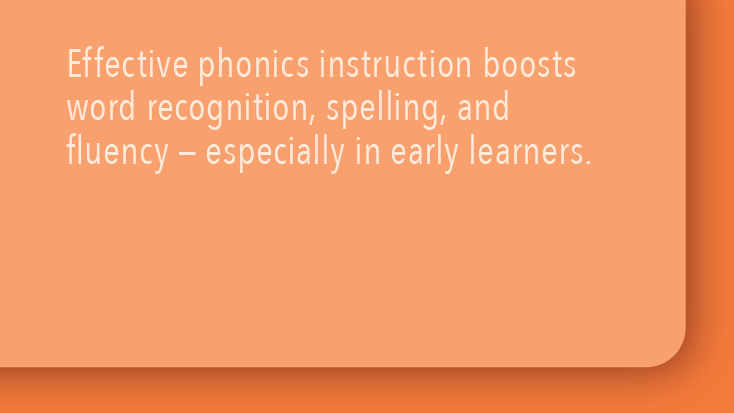
English has only 26 letters but around 44 distinct sounds (phonemes). That means your students need to understand how letters and letter combinations map to these sounds.
Phonics teaches the link between phonemes (sounds) and graphemes (how we write those sounds). Effective phonics instruction boosts word recognition, spelling, and fluency — especially in early learners.
What is an Effective Phonics Program?
- Systematic: Teach letter-sound relationships in a logical, structured order. Don't just teach A to Z in order; start with high-frequency consonants (m, s, t) and short vowels (a, i) that form simple words like "sit" and "mat."
- Explicit: Provide clear directions: what to teach, how to teach it, and when to introduce new sounds and patterns.
- Frequent Application: Let your students blend sounds, read words, and build confidence through practice with actual sentences and stories. Reinforce new patterns across multiple lessons.
- Early Start: While most effective when started early, phonics remains vital for struggling readers of any age or those with learning differences, such as dyslexia.
- Part of a Comprehensive Reading Program: Combine phonics with vocabulary, comprehension, fluency, and writing tasks for balanced literacy.
When teaching ESL students especially, connecting phonics to meaningful communication helps them see the practical value of these sound-letter relationships.
How Phonics Skills Build Over Time
Phonics builds reading skills in steps:
- Letter Recognition: Students learn to identify each letter by its name and shape.
- Letter-Sound Correspondence: They begin connecting letters to the sounds they make (example: "m" makes the "mmm" sound).
- Blending Sounds: Students combine individual sounds to read whole words (c-a-t → "cat").
- Segmenting: They break words into separate sounds for spelling ("dog" → d-o-g).
The 4 Main Types of Phonics Instruction

01
Synthetic or Blended Phonics
Synthetic phonics is the most widely adopted method by ESL companies. Students learn each sound (phoneme) one at a time, then blend or "synthesize" them to read entire words. Examples: s-a-t → sat.
How it Works:
- Use A-Z flashcards (apple for /a/) to help students associate sounds.
- Use TPR (Total Physical Response), such as hand gestures to represent mouth movements, to help learners blend sounds. F = ff fish (wiggle hand like a fish)
- Use drawing tools or whiteboards to sound out and blend words in real time during video lessons.
- Start with single-letter sounds before introducing digraphs (sh, ch) and vowel teams (ea, oa).
02
Analytic or Implicit Phonics
Rather than isolating sounds, as in synthetic phonics, it starts at the word level and teaches learners to recognize and read whole words.
How it Works:
- A student might learn to recognize the word "cat" before analyzing the individual sounds /c/, /a/, and /t/.
- Once "cat" is recognized, you might then point out that "cat," "hat," and "sat" all share the same ending sound and letter pattern.
- Works well for students who benefit from seeing the big picture.
- Useful for sight words that don't follow existing phonetic rules, like "was" or "said".
03
Analogy Phonics
A subtype of analytic phonics, students learn to decode new words by recognizing familiar spelling patterns. They look at word families — such as –ake in make, bake, and take — to read unfamiliar words with similar endings.
How it Works:
- Students learn new words by building onto familiar spelling patterns (phonograms or rhymes).
- Use parts of words they know to decode words they don't. If you know "make," you can read "bake".
- Use rhyming activities and games to reinforce these patterns.
- Create word family charts that you can reference during online lessons.
04
Embedded Phonics
Instruction occurs on an "as-needed" basis. Taught informally during story or reading time, as new words appear naturally.
Example: "Look at the word 'fish.' See how 'sh' makes that sound? What other words have 'sh'?"
How it Works:
- Works well as a supplement to more structured approaches.
- Helps students see the real-world application of phonics skills.
- Less effective for ESL students who need systematic instruction.
Which Approach Works Best Online?
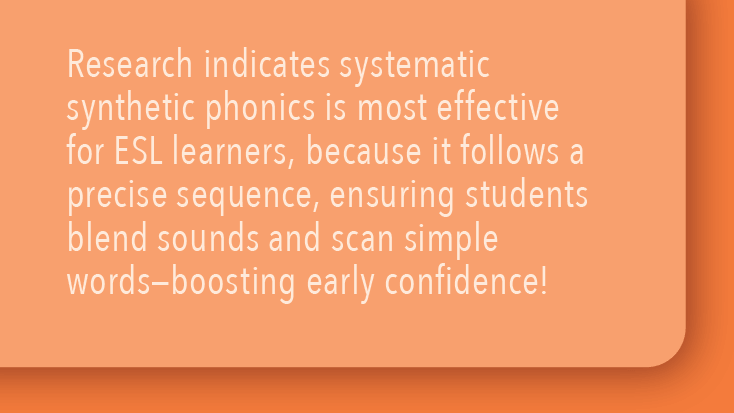
Research indicates systematic synthetic phonics is most effective for ESL learners, because it follows a precise sequence, ensuring students blend sounds and scan simple words—boosting early confidence!
How to Teach Synthetic Phonics
Focus on:
- Practice: Regular, consistent practice of newly introduced sounds.
- Engagement: Games and activities that reinforce learning.
- Application: Opportunities to use phonics in reading and writing.
After teaching each new letter sound, reinforce it with a song, a hands-on activity, and a game. Begin each lesson by reviewing previously taught sounds.
How to Teach Synthetic Phonics
If you're an online English teacher with any of the major ESL companies, you need to understand how to teach synthetic phonics.
Level 1: Teach Letter Sounds
Begin with the sound relationship for each letter, not just their names - A → /a/. C → /k/). Focus on the pure sound of each letter. Keep consonant sounds sharp and short.
Avoid adding "uh" sounds after consonants—saying "buh" instead of /b/ interferes with blending skills later.
Know which sounds are voiced and which are voiceless, so you can model them clearly. /b/ is a voiced sound (your vocal cords vibrate), while /p/ is voiceless. Knowing the difference helps children build phonemic awareness and distinguish between minimal pairs, such as "bat" vs "pat."
Focusing on phonemic awareness helps students hear the sounds before they see them. Also, teach lowercase letters first — they appear more frequently in text, and there are only 26 to learn. Master the core letter sounds before introducing blends, digraphs, or alternate spellings.
Level 2: Blending Sounds
Blending is the bridge between knowing sounds and reading words. Once students know individual sounds, help them to blend them together while reading words. For example, blending /d/ + /o/ + /g/ helps them read "dog".
Blending takes practice. Model the blending process, gradually increasing speed until the word is recognizable. Try the arm-tapping strategy to demonstrate each sound in a word:
- Tap your shoulder for the first sound /c/.
- Touch your elbow for the second sound /a/.
- Touch your wrist for the ending sound /t/.
- Slide your hand down your arm while saying the complete word ("cat").
These physical movements make sound blending more concrete and easier to remember, especially for students who need extra support connecting sounds into full words.
Level 3: Segment Sounds
Segmenting is the reverse of blending and builds essential spelling skills. Students break words into individual sounds—when hearing "pig," they identify the sounds /p/ /i/ and /g/.
Phonic Fingers Activity: Students raise one finger for each phoneme they hear in a word. This quick activity works well during transitions and provides visual reinforcement of sound counting.
Level 4: Recognizing Sight Words
Sight words are common words like and, on, or it that don't always follow phonics rules. Teaching students to recognize these high-frequency words by sight helps them read more fluently.
- Teach irregular words like eye, many, and one separately.
- Call them "tricky words" or "sight words."
- Don't expect decoding—these are memorized through repetition.
Animal Friends Sight Word Activity
When teaching children, transform toy animals into sight word champions for this engaging virtual activity.
Prep: Attach sight words to stuffed animals by writing each word on a post-it and sticking it on each animal.
Live Teaching: During your lesson, have each animal "introduce" itself and its sight word using distinct voices and personalities. When students name an animal, show it to the camera so they can read the sight word it's holding. After completion, make a sentence in the animal's voice with the word. Kids love this!
10 Practical Ways to Teach Phonics to ESL Students Online
1) Introduce Short Vowels Early
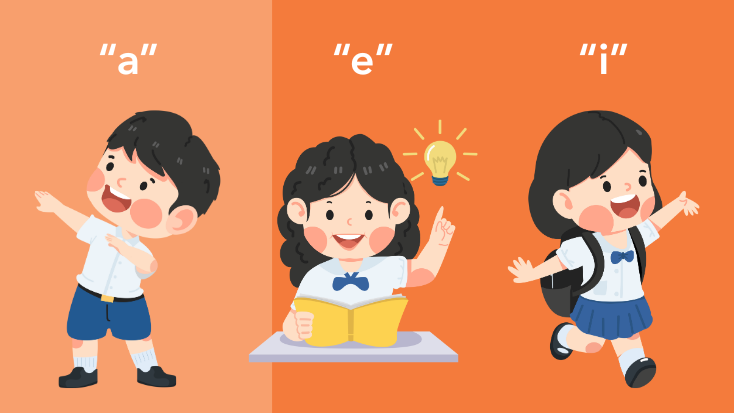
Waving Vowel Game
Many Chinese students struggle to distinguish between short a, e, and i sounds. Chinese has only 5 vowels, but English has 15. Start with voiced consonant endings so your students can easily distinguish vowel differences.
- Short "a": /æ/ – cat, flag
- Short "e": /ɛ/ – bed, head
- Short "i": /ɪ/ – big, sit
- Short "o": /ɒ/ – hot, box
- Short "u": /ʌ/ – cup, tub
Practicing minimal pairs like bad, bed, and bid will help them refine their listening skills.
Quick Teaching Game
Use movement to reinforce each vowel sound:
- Wave left for short a.
- Wave overhead for short e.
- Wave right for short i.
Model each sound and movement clearly. The students then copy the movement while repeating the sound. You now say a word aloud (e.g., bat, bet, bit), and students respond by waving in the matching direction and repeating it: "/æ/.. /æ/.. /æ/.. bat."
2) Drill Final Consonants
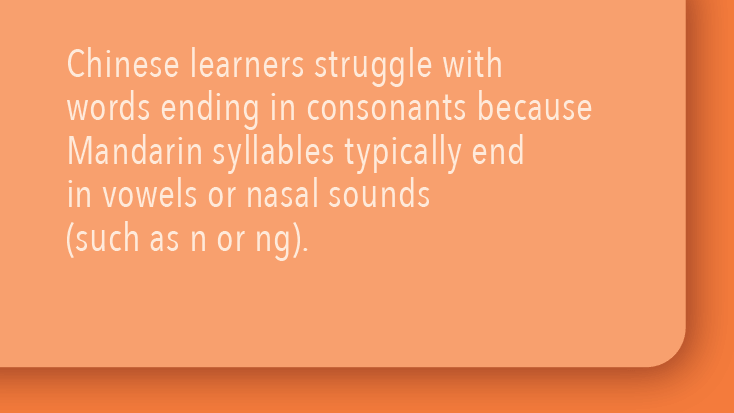
Chinese learners struggle with words ending in consonants because Mandarin syllables typically end in vowels or nasal sounds (such as n or ng). They often add vowels after final consonants - "good" becomes /ˈgʊdə/.
Why This Happens:
- Ending consonants and clusters (nd, st, mp) don't exist in Mandarin
- Students drop final sounds (map → ma) or add vowels (hot → hot-uh)
Corrective Final Consonant Activities:
- Use Echo Drills: Have students repeat words with clear stop sounds, such as hot—hot and map—map. Start slowly, then increase speed while maintaining crisp final consonants.
- Isolate the Ending Sound: Break words into parts. Practice just the final consonant (t...t...t...), then put it back into the word ("t...hot!"). Repeat the process with p...p...p... "map!"
- Final Sound Clap: Say a word like "tap." Students repeat it and clap exactly at the last sound ("tap"—clap!). The physical action makes the ending more deliberate.
3) Use Visual Mouth Modeling
Show students exactly how each sound is formed. Exaggerate the shape of your mouth when introducing new sounds. Use on-screen diagrams, TPR, and slow-motion demos to show how sounds are made. This visual approach helps them see—and mimic—correct articulation.
Target These Common Confusions
/ʃ/ and /s/ (ship vs. sip)
- Rounded vs. Flat Lips: Show how /ʃ/ uses slightly rounded lips and a focused air stream over the tongue.
- Real-Time Mirror: Have students watch your mouth as you pronounce each sound.
- Minimal Pairs Practice: Try ship/sip, sheet/seat, shore/sore.
/dʒ/ (jump, jelly)
- Common Mispronunciation: Often heard as /zh/ or /ch/ by learners.
- Blend It Right: Model /d/ (voiced stop) smoothly transitioning into /ʒ/.
- Minimal Pairs: jog vs. chop, jet vs. check.
Quick Teaching Tips
- Record & Playback: Have students record themselves saying tricky sounds, then compare them with your model.
- Spot the Shape: Show silent mouth positions. Students guess the sound you're forming.
4) Make Phonics Multi-sensory
Phonics recall sticks better when you involve all the senses:
- Shape & Say: Have young learners roll Play-Doh into letters while saying the sound out loud.
- Yoga Letters: Think YMCA as students make letter shapes with their bodies.
- Sky Letter Writing: Call out a sound. Students finger-write the letter in the air as they say the sound. Exaggerate your writing so they can follow along.
- Mirror Mouth: Let them practice /th/ and /r/ by using a hand mirror to see how their tongues and lips should move.
5) Use a Virtual Whiteboard

Perfect for quick, hands-on phonics practice.
- Visual Drills: Write a letter or digraph, and students say the matching sound. Quick and effective for sound recognition.
- Auditory Drills: Say a sound. Students write the spellings they know (e.g., /k/ → c, k, ck, ch). Reinforces sound-to-spelling connections.
- Blending Practice: Write sounds (e.g., c–a–t). Students blend to read the word. Include nonsense words like tus or lat for extra decoding practice.
- Word Chains: Start with a simple word (cat), then change one sound at a time (cat → hat → hot → hop). Students write and read each version aloud.
- Segmenting with Elkonin Boxes: Draw three boxes, say "shop," and kids write each distinct sound in a box - sh-o-p.
6) Pronunciation Puppet Pals
Puppets get kids talking fast with these 3 activities:
01
Articulation Modeling
Use puppets to demonstrate mouth movements for tricky sounds like:
- /m/: Closed lips pressed together.
- /n/: Mouth open with teeth clenched.
02
Sound Games
Pit your puppet against the class in quick "sound battles." Have it say minimal pairs like "map" vs "nap," and let students correct or identify what they hear.
03
Puppet Reactions
Let your puppet respond to the student's attempts - maybe it nods, claps, or appears confused. Deliberately mix up sounds: "Did you say rice or lice?"
7) Use Phonics Chants and Songs
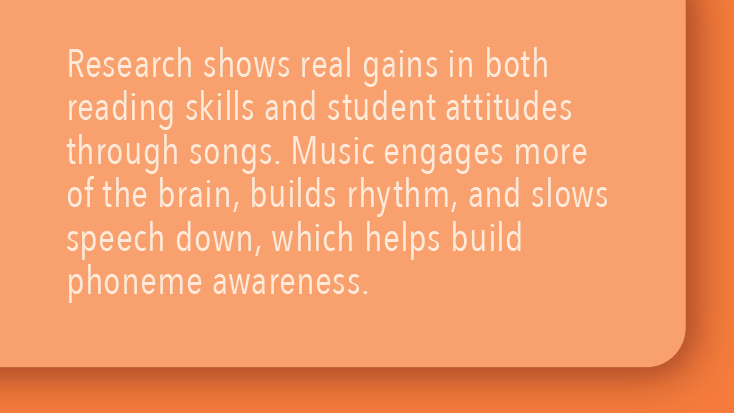
Chants and songs help phonics stick. Rhythm, melody, and repetition boost memory and pronunciation and make learning feel fun—especially for younger learners.
Research shows real gains in both reading skills and student attitudes through songs. Music engages more of the brain, builds rhythm, and slows speech down, which helps build phoneme awareness.
Why It Works for Chinese Learners
English is a stress-based language, while Mandarin is tonal. Chinese learners aren't used to stressing certain syllables. Chants bridge that gap by emphasizing beats and pitch in a new way.
They:
- Reinforce syllable stress (e.g., REcord vs. reCORD).
- Help learners feel the cadence of English.
- Improve auditory discrimination — especially with vowel sounds and connected speech.
Activities:
- Phonics Chants: Keep it simple and repetitive. Example: "S says /s/, /s/, /s/ like in sun!" Add clapping, snapping, or movement to match the beat.
- Finger-Point Reading: If you're using songs with lyrics, have students point to each word as they sing. This shifts memory from just the tune to actual word recognition.
8) Mystery Box Reveals
A low-prep yet high-engagement activity that sparks instant curiosity. Hide small objects or letters in a "mystery box" and:
- Pull them out one by one.
- Prompt students to say the letter sound (e.g., /k/ for cow).
- Ask them to connect it to a word they already know. "Do you know anymore /k? words?"
9) Syllable Chop for Long Words
English has longer words and varying stress, which is why chunking syllables helps.
- Pick a multisyllabic word: Elephant. Computer. Information.
- Chop into syllables: el-e-phant. Students clap or tap for each syllable.
- Highlight stress: Put extra emphasis on EL-e-phant so they notice where the stress goes.
This step-by-step approach trains learners to decode multi-syllable words with ease.
10) "R or L?" Minimal-Pair Battles
Many Chinese speakers often blur /r/ and /l/ because Mandarin pronounces /r/ differently. Practice a quick matchup drill to fix it:
- Prep minimal pairs: right/light, red/led, road/load.
- Show & say one word: Students point to the card they hear.
- Speed drills: Say the words faster or mix them into short sentences.
Highlight crisp mouth positioning for /r/ and /l/, and watch students' confidence soar.
Common Challenges for Asian ESL Kids (and How to Overcome Them)
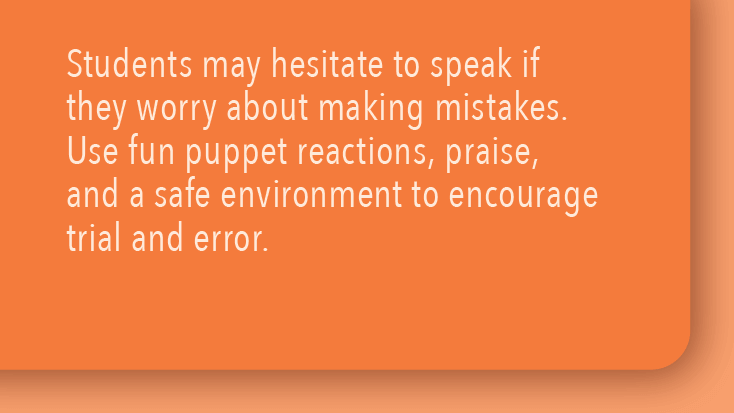
- Transliteration Habits: Pinyin (Chinese) or Hangul (Korean) are used to approximate English sounds, which can cause inaccurate pronunciation. Encourage students to form new habits by focusing on mouth modeling and listening drills.
- Tonal vs. Stress Languages: Chinese and Thai are tonal languages; Japanese uses pitch to distinguish words, whereas English relies on intonation (rising and falling pitch in a sentence). Use chants and songs to indicate where the stress should be placed.
- Confidence Issues: Students may hesitate to speak if they worry about making mistakes. Use fun puppet reactions, praise, and a safe environment to encourage trial and error.
Final Words
Synthetic phonics unlocks reading for ESL learners. Start with the basics: short vowels, final consonants, and proper mouth shapes for problem sounds. With consistent practice and creative activities, your students won't just read—they'll thrive.
